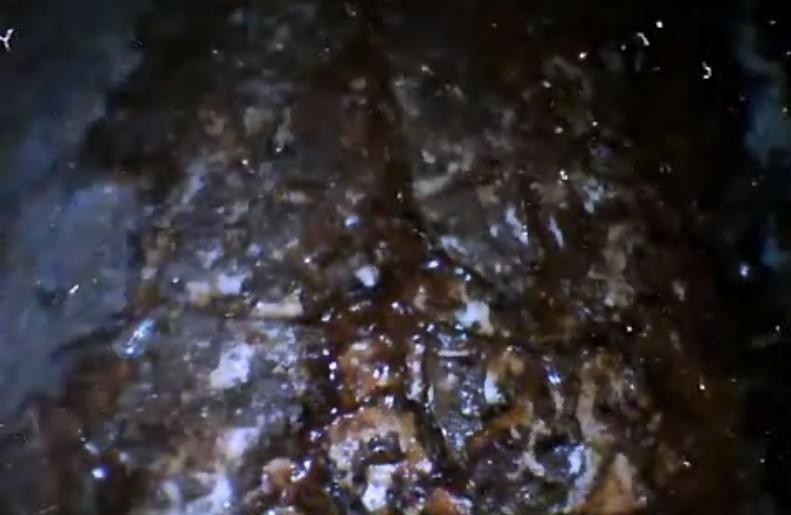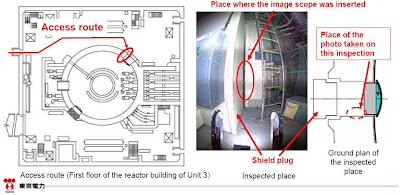TEPCO now admits that there is a gap in the shield plug on the Containment Vessel of Reactor 3, and the water may have leaked from the equipment hatch flange into the reactor building.
What a surprise. Last November, TEPCO sent a Packbot inside the Reactor 3 building and had it survey the guide rails in front of the same equipment hatch. The robot detected the maximum 1.6 sievert/hour radiation, and the guide rails filled with water and sludge-like material. The robot was seen trying to wipe off the water with cloth. There was no further announcement from TEPCO on this, until today (April 19, 2012).
This time, TEPCO sent out two of its employees for a 4-minute work of inserting an image scope through the gap to get the image of the floor in front of the equipment hatch flange.
Now the company shows us the photograph that the Packbot took last November, showing the gap between the shield plug and the CV.
From TEPCO's Photos for Press page in English, 4/19/2012 (emphasis is mine):
Inspection of the equipment hatch of PCV in Unit 3 of Fukushima Daiichi Nuclear Power Station
[Object]To check the situation of water leakage from the equipment hatch of PCV at the northeast on the first floor, as the water injected to the PCV has been leaked to the reactor building.
[Detail]
・A crevice between the shield plug and the reactor building was confirmed in the past video
・Inspection of the situation of water leakage from the flange of the equipment hatch, by inserting an image scope into the crevice between the shield plug and the reactor building
[Result of the work]
・Time:1:27 pm – 1:48 pm on April 19, 2012 (Time stayed in the reactor building : Approx. 4 minutes)
・Workers :2 TEPCO employees (Maximum radiation exposure :8.01mSv Planned:15mSv)
[Situation of the equipment hatch of the PCV]
・We checked the situation around the equipment hatch flange of PCV, and we confirmed floor surface where the water leakage could have occurred.
・Hereafter, we will study the result of the inspection in detail.
Gap:
Dry floor surface:
Floor surface where leak may have occurred:
戦争の経済学
-
ArmstrongEconomics.com, 2/9/2014より:
戦争の経済学
マーティン・アームストロング
多くの人々が同じ質問を発している- なぜ今、戦争の話がでるのか?
答えはまったく簡単だ。何千年もの昔までさかのぼる包括的なデータベースを構築する利点の一つは、それを基にいくつもの調査研究を行...
11 years ago




 Tokyo Time
Tokyo Time
![[Most Recent Quotes from www.kitco.com]](http://www.kitconet.com/charts/metals/gold/t24_au_en_usoz_2.gif)


5 comments:
Finally we have a really great recent example of TEPCO doing the 'don't ask and we won't tell' stuff. I do remember trying desperately to see more of the equipment hatch int he variety of November videos about this area, but everything was focussed on the rail back then, and they didn't mention the gap.
The other really interesting question is about the nature of the gap. Specifically, is the large square shield plug that travels on the rails, moved to a position that is more like open than closed. i.e. should the area we see coming out towards the camera in that photo, actually be flush with the wall? It seems quite reasonable to think that it should be, especially when looking that the diagrams TEPCO used. But I don't think anybody at the press conference asked about this, so getting confirmation is not easy.
Fascinating stuff. I remember wondering where the water on the rails had come from. Apparently, there was more to the rail-swiping mission than met the eye. I don't remember seeing any comments as to the composition of the liquid that was collected, by the way.
Has TEPCO confirmed yet "whether the robot was able to capture images of pipes connecting the suppression chamber and a containment vessel where the company also suspects water leakage"? A couple of days ago NHK reported that TEPCO hadn't yet confirmed this. Although NHK didn't say whether anybody had asked. As elbows says: if we don't ask, TEPCO most likely won't tell -- at least not until such time as it may best serve their PR interests.
They spent 4 minutes *in the building* and got 8 mSv. That's a whopping 120 mSv/h. And as they probably spent most of the 4 minutes walking in and out, radiation at the gap must be quite hefty. My question is: Would the radiation already indicate that the hatch is better described as open than closed?
Indeed, another example of Tepco's deceitful hiding of the truth.
If the workers' dosimeters worn at the chest indicated 8 mSv, then the feet bone marrow dose probably was more like 80+ mSv, considering the proximity of reactor containment leak effluent on the floor.
It's stunning too that even now Tepco tries to feed us off with ultra-low resolution pics that are unsuitable to draw any firm conclusions except of the door being open.
This is obviously intentful.
At least we can see that there is quite some relevant damage.
The heavy equipment hatch outer door probably didn't swing open because of just a small force only.
Why didn't Tepco tell of the hatch door being open half a year ago?
The picture of the dry concrete doesn't prove that there is no widespread cracking in the concrete.
The picture of the goo presumably leaked also indicates that probably we haven't been showed the really interesting photos.
Will there be journalists asking for the full videos of the reactor 3 explorations to prove Tepco didn't hide even more disturbing facts?
Post a Comment